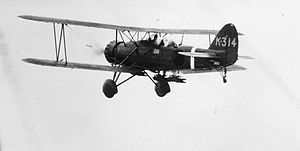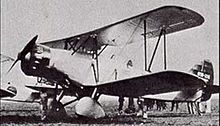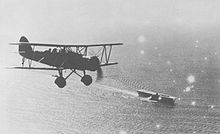Yokosuka B4Y Video - Picture

|
|
Yokosuka B4Y

Role: Torpedo bomber
Manufacturer: Yokosuka
First flight: 1935
Introduction: 1936
Retired: 1943
Number built: 205
The Yokosuka B4Y, (Navy Type 96 Carrier Attack Plane), carrier attack aircraft was used by the Imperial Japanese Navy Air Service from 1936 to 1943. The B4Y replaced the Mitsubishi B2M2 and was the last biplane bomber used operationally by the Imperial Japanese Navy. The Allied reporting name was "Jean".
Design and development
In 1932, the Imperial Japanese Navy issued a requirement for a new carrier-borne attack aircraft. Aichi, Mitsubishi and Nakajima responded to this requirement and each built a prototype. Neither of these aircraft were deemed satisfactory, and the service thus issued in 1934 a new requirement, 9-Shi, for a more capable aircraft to replace the obsolescent Yokosuka B3Y.

Airplane Picture -
The B4Y was designed by Sanae Kawasaki at the First Naval Air Technical Arsenal at Yokosuka. Regarded only as an interim type, the Navy wanted a torpedo bomber offering performance comparable to the Mitsubishi A5M monoplane fighter. The result was a biplane with fixed landing gear and an all-metal structure with metal or fabric skin. To speed development and production, the B4Y utilised the wings from the Kawanishi E7K. The B4Y1 was also the first Navy carrier attack aircraft to utilize an air-cooled engine, as the prototype that was equipped with the Nakajima Hikari 2 radial engine performed better than its opponents.
The crew of three occupied two cockpits. The pilot in the open front cockpit and the other two crewmen, (navigator and radio operator/gunner), in the enclosed rear cockpit.
Operational Service

Airplane Picture - A Type 96 flies near the aircraft carrier Kaga off China in 1937 or 1938.
On 12 December 1937 3 B4Y1s were involved in the Panay incident during a Japanese attack on the United States Navy gunboat Panay while she was anchored in the Yangtze River outside of Nanjing.
Although primarily used as a carrier-based aircraft, the B4Y1 was also used as a land-based bomber on occasion. In 1940, the Nakajima B5N replaced the B4Y1 as the primary carrier attack aircraft, though the B4Y1 did remain in service as an advanced trainer, and flew from HÅshÅ and UnyÅ until 1943.
Before its replacement, the B4Y1 had flown during the Second Sino-Japanese War and did serve at the Battle of Midway during June 1942, where eight of them were operated from HÅshÅ. It was one of these planes from HÅshÅ which took photographs of the burning HiryÅ« on 5 June 1942.
Variants
First Prototype: 559 kW (750 hp) Hiro Type 91 12-cylinder liquid-cooled engine driving a two-bladed propeller.
Second and Third Prototypes: 477 kW (640 hp) Nakajima Kotobuki-3 nine-cylinder air-cooled radial driving a two-bladed propeller.
Fourth and Fifth Prototype and Production Aircraft: 626 kW (840 hp) Nakajima Hikari-2 nine-cylinder air-cooled radial driving a two-bladed propeller.
Production
First Naval Air Technical Arsenal, Yokosuka: 5 prototypes (1935-36)
Nakajima Aircraft Company: 37 production aircraft (1937-38)
Mitsubishi Heavy Industries, Nagoya: 135 production aircraft (1937-38)
11th Naval Air Arsenal, Hiro: 28 production aircraft (1938)
Total: 205 aircraft
Operators
Japan
Imperial Japanese Navy Air Service
The B4Y1 was operated from the aircraft carriers Akagi, HÅshÅ, Kaga, RyÅ«jÅ, SÅryÅ«, and UnyÅ, as well as the 13th and 15th Kokutais (Air Groups).
Specifications
Data from Japanese Aircraft of the Pacific War
General characteristics
Crew: 3 (pilot, navigator, radio operator/gunner)
Length: 10.15 m (33 ft 3â
in)
Wingspan: 15.00 m (49 ft 2½ in)
Height: 4.36 m (14 ft 3â
in)
Wing area: 50.0 m² (538 ft²)
Empty weight: 2,000 kg (4,409 lb)
Loaded weight: 3,600 kg (7,900 lb)
Powerplant: 1 x Nakajima Hikari-2 9-cylinder radial engine, 626 kW (840 hp) (take off), 522 kW (700 hp) at 1,200 m (3,940 ft)
Performance
Maximum speed: 278 km/h (150 knots, 171 mph)
Range: 1,575 km (850 nmi, 978 mi)
Service ceiling: 6,000 m (19,700 ft)
Wing loading: 72 kg/m² (14.7 lb/ft²)
Armament
Guns: 1x flexibly mounted, rearward-firing 7.7 mm (0.303 in) Type 92 machine gun
Bombs: 1x 800 kg (1,764 lb) torpedo, or 500 kg (1,102 lb) of bombs
Bibliography
Francillon, Ph.D., René J. Japanese Aircraft of the Pacific War. London: Putnam & Company Ltd., 1970 (2nd edition 1979, 3rd 1987). ISBN 0-370-30251-6.
English Translation of Kojinsha No. 6 Warships of the Imperial Japanese Navy.
Parshall, Jonathon and Anthony Tully. Shattered Sword:The Untold Story of The Battle of Midway. Washington DC: Potomac Books, 2005. ISBN 1-57488-923-0.
Yokosuka B4Y Pictures
More airplane video.
Source: WikiPedia